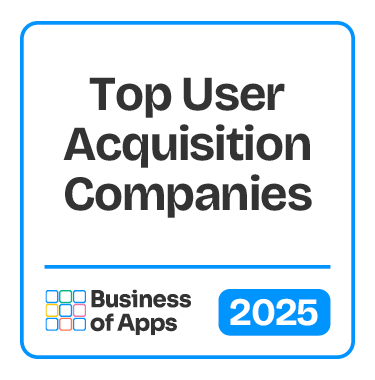User Acquisition
October 30, 2023
The Most Common Video Ad Sizes in 2023
Selecting the right ad size is critical for maximizing your ad campaign's performance. Knowing the specific dimensions that each ad network uses can help ensure that your ads are not only visually appealing but also highly effective in reaching your target audience. Here, we provide a comprehensive guide on the recommended ad sizes for 20 prominent advertising networks. Whether you're considering banner, interstitial, or native ads, this information will help you make an informed decision. If you're looking for information on banner ad sizes, make sure to check out our other guide.
Call To Action: The Driving Force
The call-to-action (CTA) in your video campaigns plays a pivotal role. To capture the attention of your target audience, it's crucial to align the CTA with the video's purpose and size. A poorly sized video can distract the audience from the CTA, decreasing engagement and conversions.
Platform-Specific Video Sizes
Understanding the video specifications for each platform can help in the effective dissemination of ads. Here are the specs you need to be aware of:
YouTube
- Video Aspect Ratio: 16:9, 4:3, 1:1
- Resolution: 1920x1080, 640x480, 460x60, 728x90
- Stories & Explore:
- Aspect Ratio: 9:16
- Resolution: 1080x1920
- Feed:
- Aspect Ratio: 4:5
- Resolution: 1080x1080
- Stories:
- Aspect Ratio: 9:16
- Resolution: 1080x1920
- Feed:
- Aspect Ratio: 1:1 or 4:5
- Resolution: 1080x1080
TikTok
- Top View and Takeover Formats: Aspect Ratios: 9:16, 1:1, 16:9
- Minimum Resolutions: ≥540 x 960p, ≥960 x 540p, or ≥640 x 640p
Snapchat
- All Formats:
- Aspect Ratio: 9:16
- Resolution: 1080x1920
Google AdMob
Google AdMob offers various ad formats like banners, interstitials, and native ads. Popular banner sizes include 320x50 for mobile and 468x60 for tablets. For interstitial ads, a 300x250 format works well. Native ads are customizable and can adapt to the size of your content.
TargetVideo Premium Demand
TargetVideo provides different ad formats, including standard banners and video. The commonly used sizes are 300x250 for display ads and 1280x720 for video ads to reach a wide audience effectively.
Amazon Publisher Services
Amazon supports various formats including display banners, native shopping ads, and video ads. Popular banner sizes are 728x90, 300x250, and 160x600. Video ads typically follow the 16:9 aspect ratio, suitable for multiple platforms.
SmartyAds
SmartyAds offers different types of ads like banners, video, and native. Common banner sizes are 728x90, 300x250, and 320x50. Video ad sizes typically align with the standard 16:9 or 4:3 ratios.
AppLovin
AppLovin supports formats like interstitials, banners, and native ads. Standard sizes include 320x50 for banner ads and 300x250 for interstitial ads. Native ads are usually customizable in size. AppLovin also has a number of rewarded video ad inventory units.
PubMatic
PubMatic supports a wide range of ad formats including display, native, and video. Standard banner sizes are 728x90 and 300x250. Video ads often adhere to a 16:9 aspect ratio.
Equativ (Formerly Smart AdServer)
Equativ offers a variety of ad types like banners, interstitials, and video ads. Commonly used sizes are 320x50 for mobile banner ads and 16:9 for video content.
Unity Ads
Unity primarily focuses on mobile game ads and usually utilizes full-screen interstitial formats. These are generally optimized for the device’s screen size and aspect ratio.
Epom Apps
Epom supports various ad formats including banners, interstitials, and native ads. Standard sizes for banners are 320x50 and 728x90, while native ads can be customized.
Digital Turbine (Formerly AdColony)
Digital Turbine offers video, interstitial, and banner ads. Standard sizes for banners include 320x50, and video content is often optimized at a 16:9 ratio.
Leadbolt
Leadbolt supports banners, interstitials, and native ads. Banner sizes are typically 320x50 and 728x90, while native ad dimensions can be customized.
InMobi
InMobi offers a variety of ad formats including banner, interstitial, and native. Standard banner sizes are 320x50 and 300x250. Interstitials and native ads adapt to screen sizes.
Smaato
Smaato supports formats like banners, interstitials, and native ads. Standard sizes include 320x50 for mobile banners and 300x250 for interstitial ads.
Start.io (Formerly StartApp)
Start.io offers several ad formats, including banners and interstitials. Standard banner sizes are 320x50, while interstitials typically use a 300x250 format.
ironSource
ironSource specializes in mobile game ads, offering interstitials, rewarded videos, and banners. Interstitials and videos are optimized for the device’s screen size, while banners typically come in 320x50.
Media.net
Media.net provides multiple ad formats, such as display ads and native ads. Standard display sizes include 300x250, 336x280, and 728x90.
Appodeal
Appodeal supports various formats like banners, interstitials, and video. Typical banner sizes are 320x50 and 728x90. Videos usually come in a 16:9 aspect ratio.
Yahoo Advertising
Yahoo supports multiple ad formats like banners, native, and video. Common sizes are 728x90, 300x250, and 160x600 for display ads. Video usually uses a 16:9 ratio.
MobFox
MobFox offers banner ads, interstitials, and native ads. Standard banner sizes include 320x50 and 300x250. Native ads are generally customizable.
Taptica
Taptica specializes in mobile advertising, offering banners and interstitials. Common sizes are 320x50 for banners and 300x250 for interstitials.
Brand Awareness and Target Audience
Matching your video ads with the appropriate aspect ratio and resolution is vital for brand awareness. Platforms like Facebook and Instagram offer multiple formats to cater to specific target audiences. Tailoring your ad sizes to these specifications will ensure that you reach your audience more effectively.
Target Audience: Crafting Your Video for the Right Eyes
Knowing your target audience is crucial for any marketing strategy, especially video advertising. The age, interests, and behavior of your audience can significantly influence the kind of content that will resonate with them. For instance, a younger audience on TikTok may prefer fast-paced, catchy videos, while a professional LinkedIn audience might appreciate a more structured and informative video. Aligning your video content with the platform's primary user base can maximize your reach and effectiveness.
1920 x 1080 and 3840 x 2160: The Standard Resolutions You Should Know
Resolution matters, and for most video advertisements, you will find yourself using either 1920 x 1080 or 3840 x 2160. These resolutions are optimal for HD and 4K displays, respectively, offering high clarity and detail, which can be particularly important for brand image and message delivery. Lower resolutions may not provide the crisp visuals that make your ad stand out, reducing the effectiveness of your campaign.
Mobile Apps: The New Frontier for Video Ads
With more people than ever using mobile applications for everything from shopping to entertainment, integrating your video ads into these platforms is an excellent strategy. Most social media platforms provide mobile-friendly formats, but it's important to remember that your video should be optimized for smaller screens. This means maintaining high-quality visuals and ensuring that text elements are legible. Your approach will vary depending on the app, but common formats include 9:16 for stories or 1:1 for feed-based videos.
Full-Screen: Making the Most of the Viewing Experience
Full-screen formats offer a more immersive experience and are especially effective for storytelling or when you want to showcase a product in detail. Most platforms offer a full-screen option, but the specifications may vary. Instagram Stories and Snapchat, for instance, use a 9:16 aspect ratio, allowing you to make the most of the vertical screen space on mobile devices. When considering a full-screen format, make sure your visuals are of high quality to leverage the larger display area effectively.
Brand Awareness: The Ultimate Goal
At the core of any video advertising strategy is the objective of building brand awareness. Whether you're aiming for the upper funnel to simply familiarize people with your brand, or the lower funnel to drive specific actions like purchases or subscriptions, video can be incredibly effective. To bolster brand awareness, you might consider using different types of videos for different platforms. For example, YouTube could be used for longer, more informative videos, while quick and engaging clips can be saved for TikTok or Instagram Stories. Always tailor your content to align with your broader brand strategy and the specific goals of each campaign.
SEASONAL CAMPAIGNS: TAPPING INTO TIMELY OPPORTUNITIES
Seasonal campaigns offer a unique opportunity to connect with your target audience during specific times of the year. For app developers, events like the back-to-school season present a golden chance to boost user acquisition. By tailoring your video ads to resonate with students, parents, and educators, you can effectively drive installs and engagement. It's essential to understand the seasonal trends and preferences of your target audience. To further explore this concept, we've detailed some insights on how app developers can capitalize on the back-to-school season.
RETARGETING: RE-ENGAGING YOUR AUDIENCE
Video ad retargeting can significantly increase user engagement by re-engaging users who may have previously interacted with your brand or app but haven't made a conversion. By showcasing compelling video content, you can remind these users of your app's benefits and features, potentially converting them into loyal customers. For a deeper dive into effective retargeting strategies, consider reading our guide on mobile app retargeting strategies for improved user engagement.
NAVIGATING AD FRAUD CHALLENGES
In the world of mobile advertising, ad fraud remains a significant challenge. Advertisers must be proactive in identifying potential threats and establishing strategies to combat them. Ensuring your video ads reach genuine users and achieve the desired outcomes requires vigilance and a keen understanding of the current ad fraud landscape. To equip yourself with the knowledge to identify and overcome these challenges, explore our article on ad fraud in mobile marketing.
THE IMPORTANCE OF USER EXPERIENCE (UX) IN VIDEO ADS
In mobile advertising, user experience (UX) cannot be overlooked. A video ad that offers a seamless and enjoyable UX is more likely to engage users and drive conversions. This means considering load times, interactivity, and ensuring the ad content aligns with the platform and device it's viewed on. For an in-depth look at how UX has evolved in mobile advertising and tips to enhance your video ads' UX, check out our article on the evolution of user experience in mobile advertising.
EXPLORING ADVERTISING APPROACHES: PROGRAMMATIC VS. DIRECT OFFERS
When deciding on your video ad distribution strategy, it's vital to understand the differences and benefits of programmatic advertising compared to direct offers. Each method has its strengths and can be suited to different campaign objectives. Programmatic advertising often offers efficiency and scale, while direct offers can provide more control and transparency. To make an informed decision on which approach is best for your campaign, delve into our comprehensive breakdown of programmatic advertising vs. direct offers.
Ready to think differently about user acquisition?
Subscribe to our newsletter and stay updated with the latest UA strategies and mobile marketing trends.





.jpg)
.webp)




